Articles of 2005
From Ghana to Gleason’s: The Journey of Kwame Asante
“The moon travels slowly, but it crosses the town.” This Ghanaian proverb belonging to the Akan people accurately describes one of their own, boxing trainer Kwame Asante.
Asante was raised in a mountainous eastern region of the country called Kwahu, where they speak Twi and are historically known as shrewd businessmen, especially in trading. His childhood reflected the relative prosperity of these parts; he remembers being “very comfortable” in the relaxed, bucolic surroundings.
But Asante was a feisty kid, and although his chosen sports were track and soccer, rarely did a day go by when he wasn’t in a fistfight. Even more rare were any telltale scars from his many battles.
“I was not angry,” says the mild-mannered 47-year-old. “I just liked fighting—a lot.” So it seemed like divine intervention when Asante’s father, who held an atypical job as a state corrections officer, was assigned to a facility in Accra, the nation’s capital and the wellspring of Ghanaian boxing.
A neighbor of Asante’s, who had been a former heavyweight champion of Africa, noticed the aggressive teenager’s preference for brawling during soccer matches rather than scoring goals. The ex-fighter encouraged him to check out the neighborhood boxing gym and offered to teach him the basics. The young man agreed, even though his father was unsupportive, hoping his son would focus on his studies instead. Admiring girls feared he would mess up his “handsome face.” (When asked if he was that handsome, Asante smiled, “Oh, yes!” his unmarked, Buddha-like features shining like polished black onyx.)
At 147 pounds and after a year of training, “no one could take me,” he says matter-of-factly.
He produces a weathered black and white photograph of himself competing in an international tournament. He is the most imposing welterweight I’ve ever seen, almost six feet tall, heavy-boned, and exceptionally muscular with shoulders and arms like great loaves of twisted black bread. Kermit Cintron would get an inferiority complex standing next to this guy.
Yet as far as confrontations outside the ropes, boxing tamed the beast in him. His personality changed and he never struck a person again.
“The idea they (his coaches) put in my mind was that as a boxer your hand is a weapon. So when you beat someone, they’re going to arrest you. I don’t ever want to put myself in that situation. You see me in the normal world, I’m very cool.”
Within two years Asante made the Ghanaian national team. Soon thereafter he was elected captain, a position he held for three years. By this time Asante had a job in the corrections department, but was essentially a full-time athlete, spending the majority of the year competing against elite amateurs all over Africa, Europe and in boxing strongholds like Cuba. He compiled a record of 53-3, most of his victories coming by knockout.
“I’m actually a boxer,” Asante says in the present tense, as if speaking of the current version himself and not the one 20 years younger and 70 pounds lighter. “I box and I have the power. I don’t just go in for the knockout, I work for it, I set traps.”
But he was hampered by ill-timed injuries that prevented him from going to the ‘84 Olympics in Los Angeles, and politics, such as with the ‘86 Commonwealth Games in Edinburgh, Scotland, which were boycotted by 32 countries, including Ghana.
Still, Asante’s career might be likened to a street ball legend that never made it to the NBA, but whose exploits on the blacktop have become mythic. His bouts were always the last on the card, the main event to which everything else was the warm-up. Top brass in politics and sports would flock to see him. Once, the sports minister had him fight two top prospects the same night: the first one was knocked unconscious within a round; the second guy, a weight class above his, never saw the third round. The audience went wild. “The place was . . .” he looks away as if in a momentary reverie. “I don’t forget that.”
Not only could he dole out punishment, but when called upon his threshold for pain was astonishing. He broke his right hand in the second round of an important national tournament, against a fighter who had represented Africa in the World Games and was considered the hardest junior middleweight in the land. Asante refused to quit, knowing this opponent would never let him forget it. He punched with the damaged hand till the end of the third and final round, disregarding the pain. “When they took the gloves off,” he recounts, “the bone was out of the flesh and the whole glove was soaked with blood.” His hand is still warped, the bone pushing at the skin like a spur.
Experiences like this inspired him to move towards what others would flee. He had heard that a young featherweight named Azumah Nelson couldn’t find sparring partners. Even professional middleweights refused to spar with him—or if they worked with him once, they never showed up the next day. When he wasn’t punishing them with his shocking power, he was humiliating them with dazzling ring savvy.
Nelson had recently become a national hero, having fought Salvador Sanchez in Madison Square Garden, and giving the Mexican legend all he could handle. Although he got stopped in the 15th round, it was a phenomenal showing for the Ghanaian who had a mere 13 professional fights and was a late substitute expected to get squashed.
“’I want to spar the champ!’” Asante told the national team’s coach, F.A. Moses. The coach scoffed at this, but the amateur kept bugging him until he relented. Nelson’s team invited Asante to the national stadium in Accra where his sparring took place. Asante’s teammates and the local boxing community couldn’t believe the kid’s nerve. What made him think he could lay a hand on mercury?
“Oh, the sparring was beautiful,” Asante recalls. I boxed. I boxed Azumah, and I made him miss a lot!” It became a matter of mercury catching him.
They went about eight rounds in front of a stadium that was nearly full. He was paid 600 cedi for the day’s work (which can’t get you a candy bar in New York today but was a lot of cash back then in Accra.). Nelson’s managers were so impressed they offered to take him on when he turned pro. He was promptly made Nelson’s regular sparring partner. “Azumah gave me a lot of respect,” Asante says, examining the skin on his hands, as coarse as elephant’s hide. “He was a nice guy.”
When Nelson beat Wilfredo Gomez for the WBC Featherweight Title in 1984, he quickly became an icon to his people, like Pele to Brazilians. Nelson, who had acquired the moniker “The Professor,” developed a friendship with Asante independent of the gym. The champion would pick up Asante at his home and they would stroll around the city. You can only imagine the cachet this association conferred upon the amateur.
In spite of his promise and obsessive dedication to training, ironically, Asante never longed to turn pro. Maybe it was his contented childhood, or the fact he never experienced the pang of hunger like so many of his countrymen? His dream had been to teach, once his amateur days were done. And now he yearned to fulfill what he believed to be his ultimate calling.
* * *
While Ghana produces a disproportionately large amount of prizefighters for a country of only 21 million, nearly all of them come from the southern coastal city of Accra. More specifically, nearly all hail from a shantytown on the outskirts of the city called Bukom, and are members of the Ga tribe.
That Asante became involved in boxing, and excelled at it, is remarkable. Members of the Akan people, and those from Kwahu, are not raised to be pugilists. His success is analogous to an affluent kid from Greenwich, Connecticut, showing up at a P.A.L. in Bed-Stuy and whooping everyone’s a**. It’s a long shot.
The men of Bukom are traditionally poor fishermen who toil in boats with no machinery, pulling in their catch with a simple net and the strength of their bodies. Children are often put to work when they ought to be entering grammar school, and never end up visiting a classroom. And fighting in the streets among the young is not merely tolerated but a ritualized activity virtually encouraged.
“It usually starts with kids going out and picking on other kids,” said Rexford Azumah Koffi, a boxing manager in Bukom. “It’s an accepted form of bullying, whereby you have to take it. The more you get bullied, the more important it is to your development.” Those tough enough to reach the top of the bully food chain are revered. “Once that happens,” says Koffi, “you’re only destined for one place—the ring.”
A roll call of Ga warriors that survived Bukom’s mean streets and wicked days fishing on the Atlantic, begins with the late Roy Ankrah. He refined his ring skills while serving in World War II with the British, and went on the claim the Commonwealth Featherweight Title in 1951. David Kotey (a.k.a. DK Poison) made his mark in the mid-70s, most notably taking the WBC Featherweight Title from Ruben Olivares in 1975, and losing gamely twice against Danny “Little Red” Lopez. But it was Azumah Nelson’s epic career, spanning from December 1979 to July 1998, that established the benchmark to which all African fighters are compared. He defended his WBC Featherweight and Super Featherweight titles a total of 20 times, defeating the likes of Wifredo Gomez, Juan LaPorte, Jeff Fenech, Calvin Grove, Gabriel Ruelas and James Leija; all first-rate battlers.
Bukom spawned several splendid boxers in Nelson’s wake during the ‘90s and into the new Millennium. Nana Konadu earned a bantamweight title. The still active Alfred “The Cobra” Kotey was also an immensely gifted bantamweight titlist during that time. Recently unretired Ike “Bazooka” Quartey was a dominant welterweight then, defending his WBA strap eight times before losing it to Oscar De La Hoya. Ben “Wonder” Tackie proved himself a worthy contender against the best junior welterweights of the last few years. Emmanuel Clottey is now a wily gatekeeper in that same class, capable of an upset on a given night, and his younger brother, Joshua, is a gifted welterweight on the cusp of a title shot.
There are countless other Bukom-bred prospects—James Armah, Ray Narh, Charles Adamu, Joshua Okine, Abdullai Amidu, Ossie Duran, Jackson Osei Bonsu, Daniel Sackey, Ablorh Sowah, Joseph Agbeko and Osumanu Adama—who might distinguish themselves.
* * *
In 1987, Ghana sponsored Asante’s studies for a year at Deutsche Hochschule fur Korperkultur (The German University for Physical Culture) in Leipzig, Germany. While this institution is infamous for being the nerve center of the GDR’s doping practices from the late 1960s through the ‘80s, it also pioneered legitimate work in training and conditioning techniques. Asante promises that everything he learned there was on the level, and invaluable to his education as a boxing trainer.
He arrived home in 1988, not long before the Summer Olympics in Seoul, Korea. He and his former teammates—which included future world champions Alfred Kotey and Ike Quartey, and hardnosed journeyman Alfred Ankamah—anticipated that he would serve as one of their main coaches. However, a dispute with bureaucrats in the national sports counsel led to Asante being forced to stay home. Embittered and disillusioned by the experience, fed up with politics and eager for a change, he and his wife decided to move to New York.
During his first year in the States Asante wanted nothing to do with boxing. The sculpted welterweight transformed into a Macy’s Day float, ballooning to 250. He worked nights as a security guard at a men’s shelter in Fort Washington. Then a friend mentioned a boxing gym in Midtown Manhattan called Kingsway. It was run by onetime Nigerian lightweight champion Michael Olajide, whose eldest son—Michael “The Silk” Olajide, Jr.—had been a popular middleweight contender.
Olajide, Sr. gave Asante a job, which included any humble task that needed doing. Many days he spent more time wielding a mop than punch pads. All the while he kept his night job, getting less sleep than President Clinton. Few knew his boxing resume, and he wasn’t the type to enlighten the ignorant. Today he is still shy and reserved, a man of few words unless he knows you well. Back then, bashful about using his modest English, he seemed to communicate solely with his eyes.
He began working out intensely, and whittled himself down to a solid light heavyweight. He sparred with many pros, got them ready for fights, but sometimes nearly pummeled the fight out of them in the process.
Tokunbo Olajide, the gym owner’s youngest son and a teenage boxing prodigy at the time, recalls Asante clashing with fellow Ghanaian and world-class cruiserweight Napoleon Tagoe.
“Tagoe was rough,” Tokunbo explains. “His face was like a Michelin tire. Hit him with a hammer and you’re still gonna get it. Probably walked around at about 205, and Kwame’s going to war with this mother[bleep]er—blow-for-blow. He starts pulling out every experienced trick in the world, too. Talk about guile and knowledge and balls.”
Asante handled himself so well on such occasions that he briefly reconsidered going pro. Then he thought better of it. It was time to lay off the ring wars and accept his next stage of life, as a teacher. Training fighters was where his ambition lay. He felt that in passing his knowledge down to others, he would create a legacy greater than anything he could produce alone in the ring.
Tokunbo Olajide and Asante had formed a close bond over the years at Kingsway. When the teenager was preparing for the Golden Gloves, their fighter-trainer relationship began to gel. When the kid turned pro—he elected not to work with his father—the two officially became a team. They moved to a new gym, Church Street, and worked like hungry dogs for a year. When he wasn’t working the graveyard shift or training Olajide, he was cultivating a sizeable white-collar clientele.
“I have to work hard in order to survive,” says Asante, who continues to do security work at night, but at less threatening places than a men’s shelter. “Hard work has always been a part of my life.” He and his wife have four kids, two of whom they had very young. He jokes that when he got off work back in Ghana, he was able to “go chill somewhere before I go home.” The New York grind affords him no such luxury.
As Tokunbo Olajide’s career progressed, different trainers were brought in; Tommy Brooks worked with them briefly, then Tommy Gallagher came aboard. But Asante has been the one mainstay throughout Olajide’s impressive 20-2 career.
For years, as soon as he got off work at 8 am, the trainer would drive straight to Olajide’s apartment and pick him up for training. When Brooks was in the picture, they commuted to Rocky Marciano Gym in Jersey City. Later, when Tommy Gallagher moved into the corner, they made the morning trek to Gleason’s in Brooklyn.
In Asante, Olajide found something beyond an exemplary coach able to teach technique or get him in shape; he found a soldier and an ally. In what’s often regarded as a dirty, treacherous business, he stands for loyalty.
“Kwame is the quintessential West African man—all the good qualities of that kind of man,” comments Olajide. “He is a mixture of hardness and softness.”
The hardness is on view when Asante is working with a fighter, or in the way he goes about his demanding routine. Laziness appalls him. He deems it one of the most despicable qualities a person can have. But the softness is manifest in the nickname Olajide gave him, and even had stitched into his satin corner jacket: Kwame Love.
* * *
For the past six years Asante has set up shop at Gleason’s Gym. Gleason’s is more than just a place to box, it’s like a meeting of the United Nations—with a spit-bucket in the corner. Every color, creed, ethnicity and religion seems to find its way to this sweaty warehouse beneath the Brooklyn Bridge. Guyanan boxers and trainers dominate one corner of the gym, playing dominoes during downtime. Immigrant fighters from another dozen Latin American countries are regularly on display. In the back of the space, a Russian trainer instructs his troops in his native tongue. Next to them is a clan of newly arrived Irish. In the middle of this global gumbo, Asante and his stable of Ghanaian fighters represent Africa (though South Africans, Nigerians, Ugandans and Kenyans make appearances, too).
Asante’s fighters—Ben Tackie, Alfred Kotey and Joshua Clottey—are famous in their native country. Here they’re just regular guys on a train, squeaking by on their way to Gleason’s. There’s also a couple of middling heavyweights whom Asante works with, but derides as “lazy.” And he used to train and manage Joshua Clottey’s older brother, Emmanuel, back when he upset Olympic gold medallist Muhammad Abdullaev two years ago.
The fighter in the group with the most promising future is Joshua Clottey (26-1, 18 KOs), though he is relatively unknown and is desperately seeking a career-defining fight. Some cognoscenti consider him the best-kept secret in the loaded welterweight division. He looks so good in the gym that world champion Zab Judah, who also trains there, doesn’t inspire more ooh’s and aah’s when he steps through the ropes to hit the pads or spar.
“What I like about him,” Asante says of his charge, “is it’s not like he just wants to go for the money. He wants to win a world title. He’s very serious about his training and improving fast. Anytime he jabs or punches the pads, I feel it. Before it was not the same.”
If Asante has any concerns about Clottey, it’s that he desires success so badly he might damage himself in his hungry pursuit of it. “He runs every morning. And even when he comes to the gym, he has to run before he starts shadowboxing. I tell him he has to take it easy, because if you try to rush you won’t go anywhere.”
This last line typifies the speaker. He is hardworking but not in a rush. He is content making slow, steady progress toward his destination. Here is a man that knows the moon will eventually cross the town and shine on him.
-

 Featured Articles4 weeks ago
Featured Articles4 weeks agoAvila Perspective, Chap. 330: Matchroom in New York plus the Latest on Canelo-Crawford
-
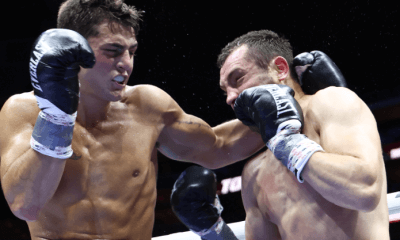
 Featured Articles3 weeks ago
Featured Articles3 weeks agoVito Mielnicki Jr Whitewashes Kamil Gardzielik Before the Home Folks in Newark
-
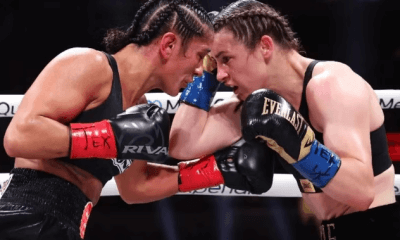
 Featured Articles9 hours ago
Featured Articles9 hours agoResults and Recaps from New York Where Taylor Edged Serrano Once Again
-
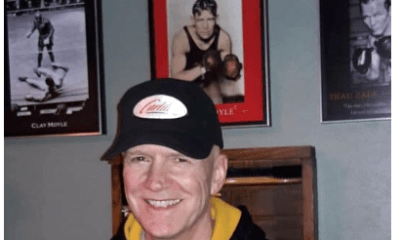
 Featured Articles4 weeks ago
Featured Articles4 weeks agoCatching Up with Clay Moyle Who Talks About His Massive Collection of Boxing Books
-
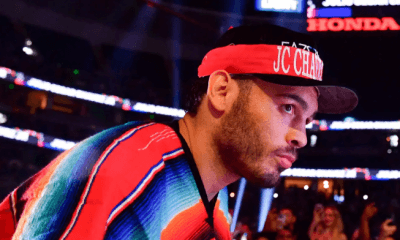
 Featured Articles5 days ago
Featured Articles5 days agoFrom a Sympathetic Figure to a Pariah: The Travails of Julio Cesar Chavez Jr
-
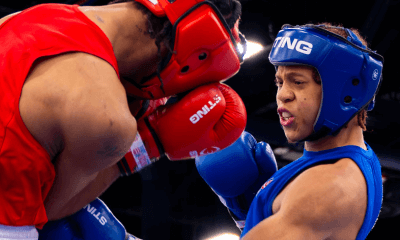
 Featured Articles3 weeks ago
Featured Articles3 weeks agoMore Medals for Hawaii’s Patricio Family at the USA Boxing Summer Festival
-
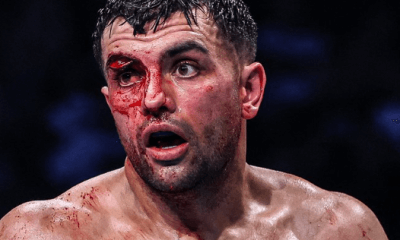
 Featured Articles7 days ago
Featured Articles7 days agoCatterall vs Eubank Ends Prematurely; Catterall Wins a Technical Decision
-
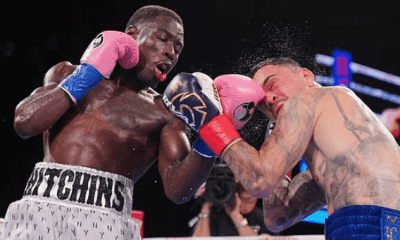
 Featured Articles4 weeks ago
Featured Articles4 weeks agoRichardson Hitchins Batters and Stops George Kambosos at Madison Square Garden

















